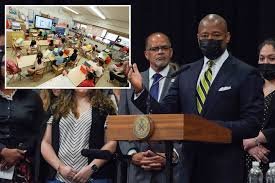Mayor Adams unveils program to address dyslexia in N.Y.C. schools

The city will assess all students to determine if they are at risk of dyslexia.
Big Apple public school students will soon be evaluated for risk of dyslexia as part of a broader effort to boost resources for children with the learning disability, Mayor Eric Adams vowed Thursday.
“We are going to have the largest, most comprehensive approach to supporting students with dyslexia in the country,” Adams — who has said he didn’t realize he had dyslexia until after struggling in high school — said at a press conference in Upper Manhattan’s P.S. 125.
“For the first time, we’re going to screen all New York City school students for dyslexia and give them the support they need to succeed.”
Adams — who advocated screening for the learning disorder during his successful Democratic mayoral primary bid — has frequently pointed to high rates of dyslexia in the city’s jail population to argue that better early-education policies can prevent New York’s youth from going down the wrong path.
The effort to get students screened will start with a pilot program, and will be expanded over the next few years, the mayor said.
In the fall, each student in kindergarten through 10th grade will undergo a brief literacy screener three times per year, according to a Department of Education spokesperson. Those who are significantly and consistently below benchmarks will have access to specific screeners for dyslexia that Adams said previously cost families hundreds of dollars, city officials said Thursday.
As part of the pilot program, 80 elementary schools and 80 middle schools in the five boroughs will receive training on how to identify and support students at risk for dyslexia, the officials said.
The DOE will also offer specialized programs for students with learning disabilities at two schools — Literacy Academy Collective in P.S. 161 in the Bronx and Lab School for Family Literacy in P.S. 125 in Manhattan — with the goal of offering at least one school in each borough “tailored for dyslexic students” by September 2023.
The Adams administration also pledged that by April next year all teachers in kindergarten through 12th grade will take a two-hour introductory training on dyslexia education.
“This is a long-term commitment,” said Schools Chancellor David Banks at the news conference. “For the first time, New York City public school students will be able to receive specialized instruction without leaving their neighborhood. This is just the beginning. We are committed to supporting all of our students.”
One Upper Manhattan parent applauded the Adams administration’s efforts to help children with dyslexia.
“For years, parent leaders, community members and I have advocated for focused support,” said Sanayi Beckles-Canton, a mother of six sons, including three with dyslexia, “because we understand that reading is a human right that all people deserve to experience.”
While her older children with the learning disability missed out on early public services, and she said she had to work two jobs to support them, Beckles-Canton was optimistic about the new opportunity for her youngest, Dylan.
“It can become a beacon of hope for children like my son,” she said.
The announcement comes after the mayor’s Executive Budget for the 2023 fiscal year unveiled last month included $7.4 million to dyslexia screening sites and literacy programs over three years.
It also comes as education advocates and public school families have recently sounded the alarm that schools have fallen short of teaching students to read.







